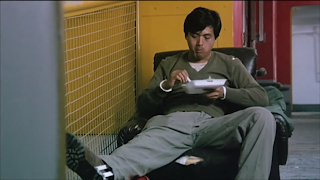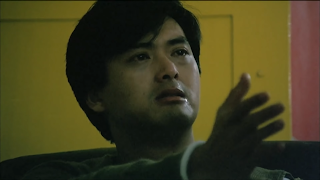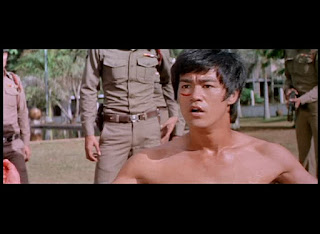A Better Tomorrow Film and Scene Analysis
A Better Tomorrow Film and Scene Analysis
by Matthew McMahon
Sikov
First Five Chapter Analysis
There are two characters presented in this
scene, Mark and Ho. The scene takes place in a garage, which is the place where
Mark works as a janitor. Mark is dressed in janitors’ clothes. The shirt is an
army color with a tear on the left shoulder with gray pants. In the first two
frames, Mark has his right leg extended with a support strapped to his shoe,
because he can no longer walk due to the shooting that occurred three years prior.
He is eating some sort of cheesy, stringy food in a depressed manner. He is
surprised to see his old friend, Ho, yet ashamed to be in the shape he is. Ho
is dressed in a street coat, with a blue undercoat and is happy to see his old
friend. He is curious as to why his old friend is ashamed. The two grab hands
and embrace one another, holding onto each other. Mark is disappointed with Ho,
because he no longer wants to be a criminal, so he walks away and lights a
cigarette. The cigarette is ignited with a lighter, and from the cigarette
comes a cloud of smoke.
The scene begins with the camera tracking
to the right, staring at Mark through a sort of fence. This gives off the
feeling that Mark was in a prison of his own. The camera moves past a wall and
suddenly cuts to a shot looking directly at Mark. The camera zooms into Mark’s face.
The camera stays rather stationary during the rest of the scene, with relatively
no movement. When Mark walks away from Ho, the camera stays still but turns its
head. Then it tracks towards Ho, when he learns about Kit following Shing because
it wants to capture Ho’s facial response to this news. Both characters are
centered on screen, whether they are alone or together. The director does not want
these characters to be isolated from the audience, he wants the audience to
connect with these characters. He wants their embrace to evoke an emotional
response. The last part of the shot has Mark placed on the right of the screen
and Ho placed towards the middle.
The scene starts off in dark lighting. When
the focus is on Mark, the lighting is dark and dim to show that he is in a very
bad place mentally and physically. When it focuses on Ho, we see it becomes brighter
to show Ho’s rebirth from prison, and second chance at life. When the two
characters embrace, it is very well lit to signify the rebirth of their
friendship and happiness. Towards the end, the lighting is neither bright nor
dark, to symbolize the neutrality of their friendship. Although they have
reunited, their ideals have shifted. We see that the camera begins focused on
Mark, with Ho foggy. Then the camera fogs out Mark and makes Ho clear.
When the camera looks at Ho, it is pointed
upward, at a low-angle shot, to signify that he is strong and tall. The camera
looks at Mark at an eye level shot, because it gives him a neutral look and the
viewer is to decide whether he is still strong or if he has weakened. Two cameras
are likely used, because one looks at Mark from one angle, and the other at Ho
from a low angle, giving the impression that the two characters are having a
conversation in which one is looking up and the other is looking down. When the
characters embrace, the shot is a 180 degrees angle, with their eye-lines parallel
to the degree.
All the music is nondiegetic. The dialogue
is diegetic. Mark’s leg seems to be nondiegetic and produced artificially but synchronized
with his movement. When Mark lights the cigarette with his lighter, the sound
is produced dietetically. The music starts off very somber, because it is a
moment in which the viewer is to feel very sad and sympathetic towards Mark. The
music starts to pick up when the two encounter each other, bring strong feeling
of nostalgia and anticipation as they reconnect. When the characters grab one another
and hug each other the music’s amplitude is heightened which causes a less
somber tone and more of a relief and happiness that the two are one again
reunited.
Complete
Analysis
A Better
Tomorrow
is an action crime film. The film focuses around two brothers on opposite sides
of the law, the trials and tribulations of two friends, and betrayal and
revenge. This film starts off with Ho waking up from nightmare about his
brother, Kit, being shot. It is likely that Ho had the idea that he was the one
who shot his brother in the back because Kit is training as a police officer
and Ho is a member of the Triad. We are then introduced to a character, Mark, who
is Ho’s Partner in crime and ever so elegant. Mark and Ho seem to hold this special bond
that transcends friendship. They are all but brothers. When we are introduced
to Kit, we see that is rather reckless. When he brings his girlfriend, Jackie,
to a music tryout, he knocks over a couple of the judges, forces them to give Jackie
a chance even though they showed up late, and breaks one of the judge’s car
windows. The beginning of the movie sets up this scenario where the audience loves
Ho and Mark and has a distaste for Kit. Both Ho and Mark are criminals, and theoretically
we should dislike them because they are bad, but we love them. Kit is in the
process of becoming an officer and, we should respect that yet, we are annoyed
by him.
The film starts to become less happy and reaches
a point of rising action when Ho is betrayed, and the father is killed. Mark
goes on to avenge his friend and loses his leg because of it. When Ho gets out
of jail, he stops at his brother Kit’s house who is angered at seeing his
brother. Kit beats him, and the relationship that was established in the beginning
of the movie has collapsed. Soon after, Ho goes to find his friend Mark to
reunite with him. We are reminded of the friendship that was established early
in the film. On one hand, Ho’s relationship with Kit has been destroyed, while
his relationship with Mark has been restored. Ho and Mark’s ideals have separated,
because Ho wants to take his second chance and live an honest life. Mark wants
to get back at the people who wronged his friend Ho, and reestablish their dominance
in the Triad.
For a while, Ho stays on the proper track
and works as a car mechanic, but the crime life still calls him. Shing tries to
get Ho to rejoin him, but Ho does not like how Shing has treated his brother
and dearest friend. Even though Ho has refused the life of crime with his
second chance, Kit remains angry with him.
Ultimately, Ho is unable to avoid the
crime life. Kit continues to pursue Shing and receives a bullet in the arm.
Shing tortures Mark and tries to force him to jump off the ledge. Then Shing
sends in his cronies to attack the car mechanic place that Ho works at. All
these events cause Mark and Ho to steal the money printer data from so they can
topple Shing’s empire. A shootout occurs at the shipyard where Mark is killed. When
Shing, Ho, and Kit are surrounded by the police, Shing turns himself in. Kit is
faced with a choice between good and evil. When Kit chooses a path of evil, he
is finally redeemed as a character. Ho returns to his status as a Big Brother
when he takes Kit’s handcuffs and has Kit turn him into the police.
The music in this film is mostly non-diegetic.
Some of the music we hear while they are in their favorite club does appears to
be diegetic. The music is rather upbeat in the beginning, but still has this
sentimental tone to it. It symbolizes this strong friendship between Mark and
Ho and their enjoyment in their current lifestyle. Everything is tranquil in
the beginning and the peace has not been disrupted. The music reaches a more chaotic
tone when Mark is at the restaurant, and he is about to shoot up the betrayers.
During Mark’s death scene, we see the music reach its most somber point.
The main characters in this film are Ho,
Kit, Mark and Shing. Ho is a character whom garners a lot of respect. In the
beginning of the movie, he enjoys the criminal activity, but cannot help but
feel it is wrong. He took a metaphorical bullet for Shing by choosing to go to
jail and let him go, but later found out he had been back stabbed. After coming
out of jail, he tries his best to stay out of crime but cannot help but protect
Mark and his younger brother Kit from Shing. Ho was a man of ownership and honor
as he avenged his fallen brother Mark and himself by killing Shing. Once again,
the viewer is pressed to think if the ends justified the means. Is a character
who is drawn to a life of crime and killing, still a good person?
Kit
is a character who starts off rather childlike. From the beginning of the
movie, Kit shows great immaturity. Kit is incredibly angry, and senselessly
beats his brother and talks down to him. He does not see the whole picture, only
his perspective. The final scene features Kit handing his gun to Ho and allowing
him to shoot down Shing, showing Kit reconnection with Ho.
Mark is a character who is elegant,
everyone loves him, and he is Ho’s best friend. In the beginning Mark is mainly
a smooth talker and does little but accompany Ho on crime activities. When Ho is
taken to prison, Mark avenges Ho’s betrayal by killing the enemies in the
restaurant. Mark loses all feeling his leg, but we see a change in Mark. He
goes from a smooth talking, elegant man, to a man driven to avenge Ho’s
betrayers.
Shing starts off as Mark and Ho’s driver. Shing
is talked down to in the beginning and treated with little respect. Shing is eventually
the one who betrays Ho and takes over Ho’s position in the Triad. Shing is the
main antagonist.
The beginning of the film is very white
and bright. This symbolizes the peacefulness and tranquility that is occurring in
the beginning of the film. The film becomes rather dark during the scenes where
the father is killed, and Ho is betrayed. The lighting is very present in this
film when we look at the prevalence of the theme of good and evil. The last sequence
at boating docks is shot at night time. This sets the stage for the decisions
that Kit must make as to whether he gives Ho the gun or not. Kit realizes that
not everything is black and white, there is a spectrum.
Sources:
Film Studies by Ed Sikov









Hi Matt,
ReplyDeleteYour scene analysis is very detailed! The beginning of the analysis gives off the impression of a screen-cap analysis, much like the assignment we had to do at the beginning of the semester. From this thick description of the characters and their clothing, you get into more of what the characters are feeling in the scene and how they are reacting to reuniting with one another, and I think this is really well done. The one line that you wrote that really stood out to me was that “Mark was in a prison of his own.” You write that Mark was in a bad place both physically and mentally, but I would have really liked to see you write more about this because I thought this connection you made with the fence and Mark’s current state was really intriguing! When you get into the analysis of the entire film, you get into a lot of detail which is really great. However, I feel like you get a bit subjective when discussing how the audience is meant to view the main characters. It is also interesting how you call Shing a main character. I mostly saw him as the villain who pops in every once in a while, but I think you are right. Overall, your blossay is really well done and was enjoying to read!
-Maddy Rodak
Thank you for your comment Maddy! I definitely should have gone more in depth regarding Mark being in a prison of his own. I would definitely agree with you regarding my evaluation of the subjectivity of the audience's view of the characters. I appreciate you taking the time to read my blossay!
DeleteGood job, this is a very detailed analysis. I liked how you focused a lot on the camera in the specific scene. It wasn't something that I had paid all that much attention too myself in the scene but your analysis of it makes sense to me. I also liked your analysis of the music and the individual characters. Overall, great job.
ReplyDeleteThank you John for your comment! I appreciate you noting my analysis of the camera movement as well as the music and individual characters. I appreciate you taking the time to read through my blossay!
DeleteLike the others said, this analysis is very detailed. I think you do a really good job at laying out all the specific plot points and character developments in a very in-depth manner. You also do a good job at establishing all of the technical aspects of the film, like the lighting and the film's various sounds. I like when you analyze these parts of the film and dissect some meaning from them, like the part about the lighting reflecting good and evil or the analysis of Kit's character toward the end. My only comment about this would be to trim down some of the summary and replace it with more of that analysis. Other than that, excellent job with this.
ReplyDeleteThank you Leo for your comment! That was definitely one of the things I had most trouble with was being a little to summary heavy, rather than balancing it out with analysis. I appreciate you taking the time to read through my blossay!
DeleteHi Matt, greatly detailed analysis, i enjoyed reading it. You have a big emphasis on camera movements in your sikov scene analysis in the beginning of your essay. This is very important in modern movements, since the higher budget affords the directors more camera work. I liked your comment about the music adjusting as the movie progresses, as i remember noticing this and appreciating it. Well thought out, detailed analysis.
ReplyDeleteThank you Issac, I really appreciate your kind words regarding my blossay!
Delete